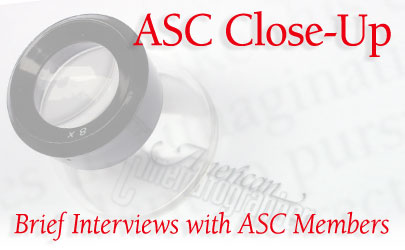 |
||||
 |
|
|||
| Henner Hofmann, ASC |
|
|||
When you were a child, what film made the strongest impression on you? Le Ballon Rouge (The Red Balloon), a French film shot in 1956 by Edmond Secan for director Albert Lamorisse. It is a magical story of a boy and a balloon that is full of charm and strong emotional undercurrents. That film left a mark on me forever. I was 7, and I remember every shot. Which cinematographers, past or present, do you most admire? In more than 100 years of cinema we’ve been honored with many fantastic cinematographers. Two names from the past would be Eduard Tisse and Nestor Almendros, ASC, AFC. From the present, I particularly admire Darius Khondji, ASC, AFC and Gordon Willis, ASC, among many others. What sparked your interest in photography? Reality and art. I grew up in Mexico, surrounded by artists in a rich cultural environment. I learned at a very early age that Mexico is a country with deep social contrasts and a vibrant culture that changes and evolves very quickly, in ways that can be abstract and surrealistic. Where did you study and/or train? I graduated from the University of Mexico City Film School in 1974. Who were your early teachers or mentors? Alex Phillips Sr. and Ghislain Cloquet, ASC, AFC, a great gentleman and an exquisite director of photography. What are some of your key artistic influences? In cinema, I would list German Expressionism, Italian Neorealism and the Cinema Novo from Brazil. In my opinion, this last movement was the most important contribution to film on the American continent, from an aesthetic and social perspective. In the world of still photography, Henri Cartier-Bresson and Alvarez Bravo were important to me as a film student and remain so today. Overall, though, I would say that the Surrealist movement is definitely my most important artistic influence. How did you get your first break in the business? I started out by working on documentaries. In those days, 16mm and 35mm ethnographic documentary films were very popular around the world, and the Mexican government was producing those kinds of movies all over the country. Members of my generation started working on these interesting cultural projects at a very young age. On the other hand, advertising was growing in Mexico and that also provided an interesting area for developing my skills as a cinematographer. What has been your most satisfying moment on a project? While watching the film dailies from the first day of shooting on Nocturno a Rosario (1992), the director, Matilde Landeta, who was 82 years old, touched my leg and said with tears in her eyes, “My picture is in color!” Her previous movie, La Negra Angustius, was shot in black-and-white during the same year I was born: 1950. Matilde died in 1999 at 89 years of age. Have you made any memorable blunders? Many big mistakes, but nothing memorable. What’s the best professional advice you’ve ever received? Gabriel Figueroa, AMC told me one day, “Your negative needs to look like an avocado skin, not like a light onion skin.” I found that to be exquisite advice for both cinematographers and chefs. What recent books, films or artworks have inspired you? Books always inspire me. My favorites are old classics and new urban stories and novels. Chinese Box (1997) is a movie that I particularly like; the simplicity of the images and the complexity of the story are fantastic. In the world of art, especially the visual arts, I found Bill Viola’s last series of works on “static motion” to be very inspiring. They are electronic paintings with a resumed motion, which is definitely a different way to approach cinematography and the fine arts. Do you have any favorite genres, or genres that you would like to try? Drama is my favorite of all. If you weren’t a cinematographer, what might you be doing instead? Architecture. I love spaces, light and structures. Which ASC cinematographers recommended you for membership? Steven Poster, Gabriel Beristain and Michael O’Shea. How has ASC membership impacted your life and career? Being in the ASC gives you the opportunity to have personal contact with the finest cinematographers in the world and exchange information from both technical and aesthetic points of view. I’ve also made new good friends, and that is important in life. |
|
|||
|
<< prev |
||||
|
|
|
|
|
|


